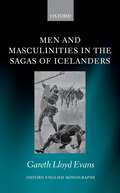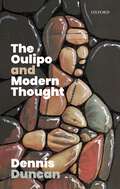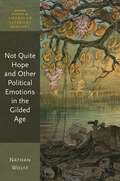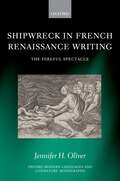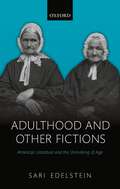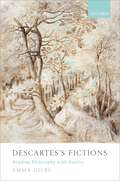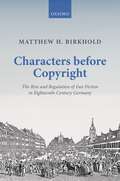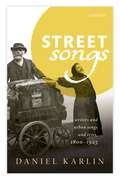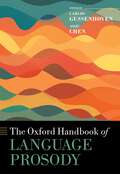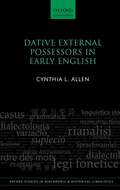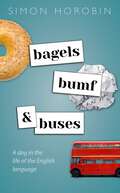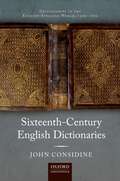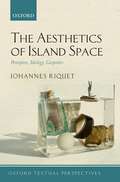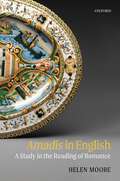- Table View
- List View
Men and Masculinities in the Sagas of Icelanders (Oxford English Monographs)
by Gareth Lloyd EvansThis volume is the first book-length study of masculinities in the Sagas of Icelanders. Spanning the entire corpus of the Sagas of Icelanders—and taking into account a number of little-studied sagas as well as the more well-known works—it comprehensively interrogates the construction, operation, and problematization of masculinities in this genre. Men and Masculinities in the Sagas of Icelanders elucidates the dominant model of masculinity that operates in the sagas, demonstrates how masculinities and masculine characters function within these texts, and investigates the means by which the sagas, and saga characters, may subvert masculine dominance. Combining close literary analysis with insights drawn from sociological theories of hegemonic and subordinated masculinities, notions of homosociality and performative gender, and psychoanalytic frameworks, the book brings to men and masculinities in saga literature the same scrutiny traditionally brought to the study of women and femininities. Ultimately, the volume demonstrates that masculinity is not simply glorified in the sagas, but is represented as being both inherently fragile and a burden to all characters, masculine and non-masculine alike.
Men and Masculinities in the Sagas of Icelanders (Oxford English Monographs)
by Gareth Lloyd EvansThis volume is the first book-length study of masculinities in the Sagas of Icelanders. Spanning the entire corpus of the Sagas of Icelanders—and taking into account a number of little-studied sagas as well as the more well-known works—it comprehensively interrogates the construction, operation, and problematization of masculinities in this genre. Men and Masculinities in the Sagas of Icelanders elucidates the dominant model of masculinity that operates in the sagas, demonstrates how masculinities and masculine characters function within these texts, and investigates the means by which the sagas, and saga characters, may subvert masculine dominance. Combining close literary analysis with insights drawn from sociological theories of hegemonic and subordinated masculinities, notions of homosociality and performative gender, and psychoanalytic frameworks, the book brings to men and masculinities in saga literature the same scrutiny traditionally brought to the study of women and femininities. Ultimately, the volume demonstrates that masculinity is not simply glorified in the sagas, but is represented as being both inherently fragile and a burden to all characters, masculine and non-masculine alike.
The Oulipo and Modern Thought
by Dennis DuncanThe impact of the Oulipo (Ouvroir de Littérature Potentielle), one of the most important groups of experimental writers of the late twentieth century, is still being felt in contemporary literature, criticism, and theory, both in Europe and the US. Founded in 1960 and still active today, this Parisian literary workshop has featured among its members such notable writers as Italo Calvino, Georges Perec, and Raymond Queneau, all sharing in its light-hearted, slightly boozy bonhomie, the convivial antithesis of the fractious, volatile coteries of the early twentieth-century avant-garde. For the last fifty years the Oulipo has undertaken the same simple goal: to investigate the potential of 'constraints' in the production of literature—that is, formal procedures such as anagrams, acrostics, lipograms (texts which exclude a certain letter), and other strange and complex devices. Yet, far from being mere parlour games, these methods have been frequently used as part of a passionate—though sometimes satirical—involvement with the major intellectual currents of the mid-twentieth century. Structuralism, psychoanalysis, Surrealism, analytic philosophy: all come under discussion in the group's meetings, and all find their way in the group's exercises in ways that, while often ironic, are also highly informed. Using meeting minutes, correspondence, and other material from the Oulipo archive at the Bibliothèque nationale de France, The Oulipo and Modern Thought shows how the group have used constrained writing as means of puckish engagement with the debates of their peers, and how, as the broader intellectual landscape altered, so too would the group's conception of what constrained writing can achieve.
The Oulipo and Modern Thought
by Dennis DuncanThe impact of the Oulipo (Ouvroir de Littérature Potentielle), one of the most important groups of experimental writers of the late twentieth century, is still being felt in contemporary literature, criticism, and theory, both in Europe and the US. Founded in 1960 and still active today, this Parisian literary workshop has featured among its members such notable writers as Italo Calvino, Georges Perec, and Raymond Queneau, all sharing in its light-hearted, slightly boozy bonhomie, the convivial antithesis of the fractious, volatile coteries of the early twentieth-century avant-garde. For the last fifty years the Oulipo has undertaken the same simple goal: to investigate the potential of 'constraints' in the production of literature—that is, formal procedures such as anagrams, acrostics, lipograms (texts which exclude a certain letter), and other strange and complex devices. Yet, far from being mere parlour games, these methods have been frequently used as part of a passionate—though sometimes satirical—involvement with the major intellectual currents of the mid-twentieth century. Structuralism, psychoanalysis, Surrealism, analytic philosophy: all come under discussion in the group's meetings, and all find their way in the group's exercises in ways that, while often ironic, are also highly informed. Using meeting minutes, correspondence, and other material from the Oulipo archive at the Bibliothèque nationale de France, The Oulipo and Modern Thought shows how the group have used constrained writing as means of puckish engagement with the debates of their peers, and how, as the broader intellectual landscape altered, so too would the group's conception of what constrained writing can achieve.
Not Quite Hope and Other Political Emotions in the Gilded Age (Oxford Studies in American Literary History)
by Nathan WolffNot Quite Hope and Other Political Emotions in the Gilded Age argues that late nineteenth-century US fiction grapples with and helps to conceptualize the disagreeable feelings that are both a threat to citizens' agency and an inescapable part of the emotional life of democracy—then as now. In detailing the corruption and venality for which the period remains known, authors including Mark Twain, Harriet Beecher Stowe, Henry Adams, and Helen Hunt Jackson evoked the depressing inefficacy of reform, the lunatic passions of the mob, and the revolting appetites of lobbyists and office seekers. Readers and critics of these Washington novels, historical romances, and satiric romans à clef have denounced these books' fiercely negative tone, seeing it as a sign of cynicism and elitism. Not Quite Hope argues, in contrast, that their distrust of politics is coupled with an intense investment in it: not quite apathy, but not quite hope. Chapters examine both common and idiosyncratic forms of political emotion, including 'crazy love', disgust, cynicism, 'election fatigue', and the myriad feelings of hatred and suspicion provoked by the figure of the hypocrite. In so doing, the book corrects critics' too-narrow focus on 'sympathy' as the American novel's model political emotion. We think of reform novels as fostering feeling for fellow citizens or for specific causes. This volume argues that Gilded Age fiction refocuses attention on the unstable emotions that continue to shape our relation to politics as such.
Not Quite Hope and Other Political Emotions in the Gilded Age (Oxford Studies in American Literary History)
by Nathan WolffNot Quite Hope and Other Political Emotions in the Gilded Age argues that late nineteenth-century US fiction grapples with and helps to conceptualize the disagreeable feelings that are both a threat to citizens' agency and an inescapable part of the emotional life of democracy—then as now. In detailing the corruption and venality for which the period remains known, authors including Mark Twain, Harriet Beecher Stowe, Henry Adams, and Helen Hunt Jackson evoked the depressing inefficacy of reform, the lunatic passions of the mob, and the revolting appetites of lobbyists and office seekers. Readers and critics of these Washington novels, historical romances, and satiric romans à clef have denounced these books' fiercely negative tone, seeing it as a sign of cynicism and elitism. Not Quite Hope argues, in contrast, that their distrust of politics is coupled with an intense investment in it: not quite apathy, but not quite hope. Chapters examine both common and idiosyncratic forms of political emotion, including 'crazy love', disgust, cynicism, 'election fatigue', and the myriad feelings of hatred and suspicion provoked by the figure of the hypocrite. In so doing, the book corrects critics' too-narrow focus on 'sympathy' as the American novel's model political emotion. We think of reform novels as fostering feeling for fellow citizens or for specific causes. This volume argues that Gilded Age fiction refocuses attention on the unstable emotions that continue to shape our relation to politics as such.
Shipwreck in French Renaissance Writing (Oxford Modern Languages and Literature Monographs)
by Jennifer H. OliverIn the sixteenth century, a period of proliferating transatlantic travel and exploration, and, latterly, religious civil wars in France, the ship is freighted with political and religious, as well as poetic, significance; symbolism that reaches its height when ships—both real and symbolic—are threatened with disaster. The Direful Spectacle argues that, in the French Renaissance, shipwreck functions not only as an emblem or motif within writing, but as a part, or the whole, of a narrative, in which the dynamics of spectatorship and of co-operation are of constant concern. The possibility of ethical distance from shipwreck—imagined through the Lucretian suave mari magno commonplace—is constantly undermined, not least through a sustained focus on the corporeal. This book examines the ways in which the ship and the body are made analogous in Renaissance shipwreck writing; bodies are described and allegorized in nautical terms, and, conversely, ships themselves become animalized and humanized. Secondly, many texts anticipate that the description of shipwreck will have an affect not only on its victims, but on those too of spectators, listeners, and readers. This insistence on the physicality of shipwreck is also reflected in the dynamic of bricolage that informs the production of shipwreck texts in the Renaissance. The dramatic potential of both the disaster and the process of rebuilding is exploited throughout the century, culminating in a shipwreck tragedy. By the late Renaissance, shipwreck is not only the end, but often forms the beginning of a story.
Shipwreck in French Renaissance Writing (Oxford Modern Languages and Literature Monographs)
by Jennifer H. OliverIn the sixteenth century, a period of proliferating transatlantic travel and exploration, and, latterly, religious civil wars in France, the ship is freighted with political and religious, as well as poetic, significance; symbolism that reaches its height when ships—both real and symbolic—are threatened with disaster. The Direful Spectacle argues that, in the French Renaissance, shipwreck functions not only as an emblem or motif within writing, but as a part, or the whole, of a narrative, in which the dynamics of spectatorship and of co-operation are of constant concern. The possibility of ethical distance from shipwreck—imagined through the Lucretian suave mari magno commonplace—is constantly undermined, not least through a sustained focus on the corporeal. This book examines the ways in which the ship and the body are made analogous in Renaissance shipwreck writing; bodies are described and allegorized in nautical terms, and, conversely, ships themselves become animalized and humanized. Secondly, many texts anticipate that the description of shipwreck will have an affect not only on its victims, but on those too of spectators, listeners, and readers. This insistence on the physicality of shipwreck is also reflected in the dynamic of bricolage that informs the production of shipwreck texts in the Renaissance. The dramatic potential of both the disaster and the process of rebuilding is exploited throughout the century, culminating in a shipwreck tragedy. By the late Renaissance, shipwreck is not only the end, but often forms the beginning of a story.
Adulthood and Other Fictions: American Literature and the Unmaking of Age
by Sari EdelsteinWhile the field of childhood studies has blossomed in recent years, few scholars have taken up the question of age more broadly as a lens for reading American literature. Adulthood and Other Fictions shows how a diverse array of nineteenth-century writers, thinkers, and artists responded to the rise of chronological age in social and political life. Over the course of the century, age was added to the census; schools were organized around age groups; birthday cards were mass-produced; geriatrics became a medical specialty. Adulthood and Other Fictions reads American literature as a rich, critical account of this modern culture of age, and it examines how our most well-known writers registered—and often resisted—age expectations, particularly as they applied to women and people of color. More than simply adding age to the list of identity categories that have become de rigueur sites of scholarly attention, Adulthood and Other Fictions argues that these other measures of social location (race, gender, sexuality, class) are largely legible through the seemingly more natural and essential identity defined by age. That is, longstanding cultural ideals about maturity and development anchor ideologies of heterosexuality, race, nationalism, and capitalism, and in this sense, age rhetoric serves as one of our most pervasive disciplinary discourses. Writers including Louisa May Alcott, Frederick Douglass, and Henry James anticipated the ageism of our moment, but they also recognized how age norms both structure and limit the lives of individuals at all points on the age continuum. Ultimately, the volume argues for an intersectional understanding of age that challenges the celebration of independence and autonomy imbricated in US fantasies of adulthood and in American identity itself.
Adulthood and Other Fictions: American Literature and the Unmaking of Age
by Sari EdelsteinWhile the field of childhood studies has blossomed in recent years, few scholars have taken up the question of age more broadly as a lens for reading American literature. Adulthood and Other Fictions shows how a diverse array of nineteenth-century writers, thinkers, and artists responded to the rise of chronological age in social and political life. Over the course of the century, age was added to the census; schools were organized around age groups; birthday cards were mass-produced; geriatrics became a medical specialty. Adulthood and Other Fictions reads American literature as a rich, critical account of this modern culture of age, and it examines how our most well-known writers registered—and often resisted—age expectations, particularly as they applied to women and people of color. More than simply adding age to the list of identity categories that have become de rigueur sites of scholarly attention, Adulthood and Other Fictions argues that these other measures of social location (race, gender, sexuality, class) are largely legible through the seemingly more natural and essential identity defined by age. That is, longstanding cultural ideals about maturity and development anchor ideologies of heterosexuality, race, nationalism, and capitalism, and in this sense, age rhetoric serves as one of our most pervasive disciplinary discourses. Writers including Louisa May Alcott, Frederick Douglass, and Henry James anticipated the ageism of our moment, but they also recognized how age norms both structure and limit the lives of individuals at all points on the age continuum. Ultimately, the volume argues for an intersectional understanding of age that challenges the celebration of independence and autonomy imbricated in US fantasies of adulthood and in American identity itself.
Descartes's Fictions: Reading Philosophy with Poetics
by Emma GilbyDescartes's Fictions traces common movements in early modern philosophy and literary method. Emma Gilby reassesses the significance of Descartes's writing by bringing his philosophical output into contact with the literary treatises, exempla, and debates of his age. She argues that humanist theorizing about poetics represents a vital intellectual context for Descartes's work. She offers readings of the controversies to which this poetic theory gives rise, with particular reference to the genre of tragicomedy, questions of verisimilitude or plausibility, and the figures of Guez de Balzac and Pierre Corneille. Drawing on what Descartes says about, and to, his many contemporaries and correspondents embedded in the early modern republic of letters, this volume shows that poetics provides a repository of themes and images to which he returns repeatedly: fortune, method, error, providence, passion, and imagination, for instance. Like the poets and theorists of his age, Descartes is also drawn to the forms of attention that people may bring to his work. This interest finds expression in the mature Cartesian metaphysics of the Meditations, as well as, later, in the moral philosophy of his correspondence with Elisabeth of Bohemia or the Passions of the Soul. This volume thus bridges the gap between Cartesian criticism and late-humanist literary culture in France.
Descartes's Fictions: Reading Philosophy with Poetics
by Emma GilbyDescartes's Fictions traces common movements in early modern philosophy and literary method. Emma Gilby reassesses the significance of Descartes's writing by bringing his philosophical output into contact with the literary treatises, exempla, and debates of his age. She argues that humanist theorizing about poetics represents a vital intellectual context for Descartes's work. She offers readings of the controversies to which this poetic theory gives rise, with particular reference to the genre of tragicomedy, questions of verisimilitude or plausibility, and the figures of Guez de Balzac and Pierre Corneille. Drawing on what Descartes says about, and to, his many contemporaries and correspondents embedded in the early modern republic of letters, this volume shows that poetics provides a repository of themes and images to which he returns repeatedly: fortune, method, error, providence, passion, and imagination, for instance. Like the poets and theorists of his age, Descartes is also drawn to the forms of attention that people may bring to his work. This interest finds expression in the mature Cartesian metaphysics of the Meditations, as well as, later, in the moral philosophy of his correspondence with Elisabeth of Bohemia or the Passions of the Soul. This volume thus bridges the gap between Cartesian criticism and late-humanist literary culture in France.
Characters Before Copyright: The Rise and Regulation of Fan Fiction in Eighteenth-Century Germany (Law and Literature)
by Matthew H. BirkholdHow did authors control the literary fates of fictional characters before the existence of copyright? Could a second author do anything with another author's character? Situated between the decline of the privilege system and the rise of copyright, literary borrowing in eighteenth-century Germany has long been considered unregulated. This book tells a different story. Characters before Copyright documents the surprisingly widespread eighteenth-century practice of writing fan fictionliterary works written by readers who appropriate preexisting characters invented by other authorsand reconstructs the contemporaneous debate about the literary phenomenon. Like fan fiction today, these texts took the form of sequels, prequels, and spinoffs. Analyzing the evolving reading, writing, and consumer habits of late-eighteenth-century Germany, Characters before Copyright identifies the social, economic, and aesthetic changes that fostered the rapid rise of fan fiction after 1750. Based on archival work and an ethnographic approach borrowed from legal anthropology, this book then uncovers the unwritten customary norms that governed the production of these works. Characters before Copyright thus reinterprets the eighteenth-century literary commons, arguing that what may appear to have been the free circulation of characters was actually circumscribed by an exacting set of rules and conditions. These norms translated into a unique type of literature that gave rise to remarkable forms of collaborative authorship and originality. Characters before Copyright provides a new perspective on the eighteenth-century book trade and the rise of intellectual property, reevaluating the concept of literary property, the history of moral rights, and the tradition of free culture.
Characters Before Copyright: The Rise and Regulation of Fan Fiction in Eighteenth-Century Germany (Law and Literature)
by Matthew H. BirkholdHow did authors control the literary fates of fictional characters before the existence of copyright? Could a second author do anything with another author's character? Situated between the decline of the privilege system and the rise of copyright, literary borrowing in eighteenth-century Germany has long been considered unregulated. This book tells a different story. Characters before Copyright documents the surprisingly widespread eighteenth-century practice of writing fan fictionliterary works written by readers who appropriate preexisting characters invented by other authorsand reconstructs the contemporaneous debate about the literary phenomenon. Like fan fiction today, these texts took the form of sequels, prequels, and spinoffs. Analyzing the evolving reading, writing, and consumer habits of late-eighteenth-century Germany, Characters before Copyright identifies the social, economic, and aesthetic changes that fostered the rapid rise of fan fiction after 1750. Based on archival work and an ethnographic approach borrowed from legal anthropology, this book then uncovers the unwritten customary norms that governed the production of these works. Characters before Copyright thus reinterprets the eighteenth-century literary commons, arguing that what may appear to have been the free circulation of characters was actually circumscribed by an exacting set of rules and conditions. These norms translated into a unique type of literature that gave rise to remarkable forms of collaborative authorship and originality. Characters before Copyright provides a new perspective on the eighteenth-century book trade and the rise of intellectual property, reevaluating the concept of literary property, the history of moral rights, and the tradition of free culture.
Street Songs: Writers and urban songs and cries, 1800-1925 (Clarendon Lectures in English)
by Daniel KarlinThis book, based on the Clarendon Lectures for 2016, is about the use made by poets and novelists of street songs and cries. Karlin begins with the London street-vendor's cry of 'Cherry-ripe!', as it occurs in poems from the sixteenth to the twentieth century: the 'Cries of London' (and Paris) exemplify the fascination of this urban art to writers of every period. Focusing on nineteenth and early twentieth century writers, the book traces the theme in works by William Wordsworth, Elizabeth Barrett Browning, Robert Browning, Walt Whitman, George Gissing, James Joyce, Virginia Woolf, and Marcel Proust. As well as street-cries, these writers incorporate ballads, folk songs, religious and political songs, and songs of their own invention into crucial scenes, and the singers themselves range from a one-legged beggar in Dublin to a famous painter in fifteenth-century Florence. The book concludes with the beautiful and unlikely 'song' of a knife-grinder's wheel. Throughout the book Karlin emphasizes the rich complexity of his subject. The street singer may be figured as an urban Orpheus, enchanting the crowd and possessed of magical powers of healing and redemption; but the barbaric din of the modern city is never far away, and the poet who identifies with Orpheus may also dread his fate. And the fugitive, transient nature of song offers writers a challenge to their more structured art. Overheard in fragments, teasing, ungraspable, the street song may be 'captured' by a literary work but is never, finally, tamed.
The Oxford Handbook of Language Prosody (Oxford Handbooks)
by Carlos Gussenhoven Aoju ChenThis handbook presents detailed accounts of current research in all aspects of language prosody, written by leading experts from different disciplines. The last four decades have seen major theoretical and empirical breakthroughs in the field, many of them informed by interdisciplinary approaches, as reflected in this volume. Following an introductory section covering the fundamentals of language prosody research, Parts II and III trace out the position of prosody in linguistic structure and explore prosody in speech perception and production. Part IV provides overviews of prosodic systems across the world, with case studies from Africa, Asia, Europe, Australia and the Pacific, and the Americas. The chapters in Parts V, VI, and VII investigate prosody in communication, in language processing, and in language acquisition, while Part VIII examines prosody in technology and the arts. The volume's comprehensive coverage and multidisciplinary perspectives will make it an invaluable resource for all researchers, students, and practitioners interested in prosody.
The Oxford Handbook of Language Prosody (Oxford Handbooks)
by Carlos Gussenhoven Aoju ChenThis handbook presents detailed accounts of current research in all aspects of language prosody, written by leading experts from different disciplines. The last four decades have seen major theoretical and empirical breakthroughs in the field, many of them informed by interdisciplinary approaches, as reflected in this volume. Following an introductory section covering the fundamentals of language prosody research, Parts II and III trace out the position of prosody in linguistic structure and explore prosody in speech perception and production. Part IV provides overviews of prosodic systems across the world, with case studies from Africa, Asia, Europe, Australia and the Pacific, and the Americas. The chapters in Parts V, VI, and VII investigate prosody in communication, in language processing, and in language acquisition, while Part VIII examines prosody in technology and the arts. The volume's comprehensive coverage and multidisciplinary perspectives will make it an invaluable resource for all researchers, students, and practitioners interested in prosody.
Dative External Possessors in Early English (Oxford Studies in Diachronic and Historical Linguistics #39)
by Cynthia L. AllenThis volume is the first systematic, corpus-based examination of dative external possessors in Old and Early Middle English and their diachronic development. Modern English is unusual among European languages in not having a productive dative external possessor construction, whereby the possessor is in the dative case and behaves like an element of the sentence rather than part of the possessive phrase. This type of construction was found in Old English, however, especially in expressions of inalienable possession; it appeared in variation with the internal possessors in the genitive case, which then became the only productive possibility in Middle English. In this book, Cynthia Allen traces the use of dative external possessors in the texts of the Old and early Middle English periods and explores how the empirical data fit with the hypotheses put forward to date. She draws on recent developments in linguistic theory to evaluate both language-internal explanations for the loss of the dative construction and the possible role of language contact, especially with the Brythonic Celtic languages. The book will be of interest to students and researchers in the fields of historical syntax and morphology, language variation and change, and the comparative syntax of the Germanic languages.
Bagels, Bumf, and Buses: A Day in the Life of the English Language
by Simon HorobinWhere do our everyday words come from? The bagel you eat for breakfast, the bumf you have to wade through at the office, and the bus that takes you home again: we use these words without thinking about their origins or how their meanings have changed over time. Simon Horobin takes the reader on a journey through a typical day, showing how the words we use to describe routine activities - getting up, going to work, eating meals - have surprisingly fascinating histories.
Bagels, Bumf, and Buses: A Day in the Life of the English Language
by Simon HorobinWhere do our everyday words come from? The bagel you eat for breakfast, the bumf you have to wade through at the office, and the bus that takes you home again: we use these words without thinking about their origins or how their meanings have changed over time. Simon Horobin takes the reader on a journey through a typical day, showing how the words we use to describe routine activities - getting up, going to work, eating meals - have surprisingly fascinating histories.
Sixteenth-Century English Dictionaries
by John ConsidineThis is the first volume in the trilogy Dictionaries in the English-Speaking World, 1500-1800, which will offer a new history of lexicography in and beyond the early modern British Isles. The volume explores the dictionaries, wordlists, and glossaries that were compiled and read by speakers of English from the end of the Middle Ages to the year 1600. These include the first printed dictionaries in which English words were collected; the dictionaries of Latin used by all educated English-speakers, from young children to Shakespeare to adult royalty; the dictionaries of modern languages that gave English-speakers access to the languages and cultures of continental Europe; dictionaries and wordlists documenting other languages from Armenian to Malagasy to Welsh; and a great variety of specialized English wordlists. No unified history has ever surveyed this vast, lively, and culturally significant lexicographical output before. The guiding principle of the book, and the trilogy, is that a story about dictionaries must also be a story about human beings. John Considine offers a full and sympathetic account of those who compiled and used these works, and those who supported them financially, paying particular attention to records of dictionary use and its traces in surviving copies. The volume will appeal to all those interested in the languages and literary cultures of the sixteenth-century English-speaking world.
The Aesthetics of Island Space: Perception, Ideology, Geopoetics (Oxford Textual Perspectives)
by Johannes RiquetOxford Textual Perspectives is a series of informative and provocative studies focused upon literary texts (conceived of in the broadest sense of that term) and the technologies, cultures, and communities that produce, inform, and receive them. It provides fresh interpretations of fundamental works and of the vital and challenging issues emerging in English literary studies. By engaging with the materiality of the literary text, its production, and reception history, and frequently testing and exploring the boundaries of the notion of text itself, the volumes in the series question familiar frameworks and provide innovative interpretations of both canonical and less well-known works. The Aesthetics of Island Space discusses islands as central figures in the modern experience of space. It examines the spatial poetics of islands in literary texts, from Shakespeare's The Tempest to Ghosh's The Hungry Tide, in the journals of explorers and scientists such as James Cook and Charles Darwin, and in Hollywood cinema. It traces the ways in which literary and cinematic islands have functioned as malleable spatial figures that offer vivid perceptual experiences as well as a geopoetic oscillation between the material energies of words and images and the energies of the physical world. The chapters focus on America's island gateways (Roanoke and Ellis Island), visions of tropical islands (Tahiti and imagined South Sea islands), the islands of the US-Canadian border region in the Pacific Northwest, and the imaginative appeal of mutable islands. It argues that modern voyages of discovery posed considerable perceptual and cognitive challenges to the experience of space, and that these challenges were negotiated in complex and contradictory ways via poetic engagement with islands. Discussions of island narratives in postcolonial theory have broadened understanding of how islands have been imagined as geometrical abstractions, bounded spaces easily subjected to the colonial gaze. There is, however, a second story of islands in the Western imagination which runs parallel to this colonial story. In this alternative account, the modern experience of islands in the age of discovery went hand in hand with a disintegration of received models of understanding global space. Drawing on and rethinking (post-)phenomenological, geocritical, and geopoetic theories, The Aesthetics of Island Space argues that the modern experience of islands as mobile and shifting territories implied a dispersal, fragmentation, and diversification of spatial experience, and it explores how this disruption is registered and negotiated by both non-fictional and fictional responses.
The Aesthetics of Island Space: Perception, Ideology, Geopoetics (Oxford Textual Perspectives)
by Johannes RiquetOxford Textual Perspectives is a series of informative and provocative studies focused upon literary texts (conceived of in the broadest sense of that term) and the technologies, cultures, and communities that produce, inform, and receive them. It provides fresh interpretations of fundamental works and of the vital and challenging issues emerging in English literary studies. By engaging with the materiality of the literary text, its production, and reception history, and frequently testing and exploring the boundaries of the notion of text itself, the volumes in the series question familiar frameworks and provide innovative interpretations of both canonical and less well-known works. The Aesthetics of Island Space discusses islands as central figures in the modern experience of space. It examines the spatial poetics of islands in literary texts, from Shakespeare's The Tempest to Ghosh's The Hungry Tide, in the journals of explorers and scientists such as James Cook and Charles Darwin, and in Hollywood cinema. It traces the ways in which literary and cinematic islands have functioned as malleable spatial figures that offer vivid perceptual experiences as well as a geopoetic oscillation between the material energies of words and images and the energies of the physical world. The chapters focus on America's island gateways (Roanoke and Ellis Island), visions of tropical islands (Tahiti and imagined South Sea islands), the islands of the US-Canadian border region in the Pacific Northwest, and the imaginative appeal of mutable islands. It argues that modern voyages of discovery posed considerable perceptual and cognitive challenges to the experience of space, and that these challenges were negotiated in complex and contradictory ways via poetic engagement with islands. Discussions of island narratives in postcolonial theory have broadened understanding of how islands have been imagined as geometrical abstractions, bounded spaces easily subjected to the colonial gaze. There is, however, a second story of islands in the Western imagination which runs parallel to this colonial story. In this alternative account, the modern experience of islands in the age of discovery went hand in hand with a disintegration of received models of understanding global space. Drawing on and rethinking (post-)phenomenological, geocritical, and geopoetic theories, The Aesthetics of Island Space argues that the modern experience of islands as mobile and shifting territories implied a dispersal, fragmentation, and diversification of spatial experience, and it explores how this disruption is registered and negotiated by both non-fictional and fictional responses.
Amadis in English: A Study in the Reading of Romance
by Helen MooreThis is a book about readers: readers reading, and readers writing. They are readers of all ages and from all ages: young and old, male and female, from Europe and the Americas. The book they are reading is the Spanish chivalric romance Amadís de Gaula, known in English as Amadis de Gaule. Famous throughout the sixteenth century as the pinnacle of its fictional genre, the cultural functions of Amadis were further elaborated by the publication of Cervantes's Don Quixote in 1605, in which Amadis features as Quixote's favourite book. Amadis thereby becomes, as the philosopher Ortega y Gasset terms it, 'enclosed' within the modern novel and part of the imaginative landscape of British reader-authors such Mary Shelley, Smollett, Keats, Southey, Scott, and Thackeray. Amadis in English ranges from the sixteenth to the twentieth centuries, demonstrating through this 'biography' of a book the deep cultural, intellectual, and political connections of English, French, and Spanish literature across five centuries. Simultaneously an ambitious work of transnational literary history and a new intervention in the history of reading, this study argues that romance is historically located, culturally responsive, and uniquely flexible in the re-creative possibilities it offers readers. By revealing this hitherto unexamined reading experience connecting readers of all backgrounds, Amadis in English also offers many new insights into the politicisation of literary history; the construction and misconstruction of literary relations between England, France, and Spain; the practice and pleasures of reading fiction; and the enduring power of imagination.
Amadis in English: A Study in the Reading of Romance
by Helen MooreThis is a book about readers: readers reading, and readers writing. They are readers of all ages and from all ages: young and old, male and female, from Europe and the Americas. The book they are reading is the Spanish chivalric romance Amadís de Gaula, known in English as Amadis de Gaule. Famous throughout the sixteenth century as the pinnacle of its fictional genre, the cultural functions of Amadis were further elaborated by the publication of Cervantes's Don Quixote in 1605, in which Amadis features as Quixote's favourite book. Amadis thereby becomes, as the philosopher Ortega y Gasset terms it, 'enclosed' within the modern novel and part of the imaginative landscape of British reader-authors such Mary Shelley, Smollett, Keats, Southey, Scott, and Thackeray. Amadis in English ranges from the sixteenth to the twentieth centuries, demonstrating through this 'biography' of a book the deep cultural, intellectual, and political connections of English, French, and Spanish literature across five centuries. Simultaneously an ambitious work of transnational literary history and a new intervention in the history of reading, this study argues that romance is historically located, culturally responsive, and uniquely flexible in the re-creative possibilities it offers readers. By revealing this hitherto unexamined reading experience connecting readers of all backgrounds, Amadis in English also offers many new insights into the politicisation of literary history; the construction and misconstruction of literary relations between England, France, and Spain; the practice and pleasures of reading fiction; and the enduring power of imagination.
